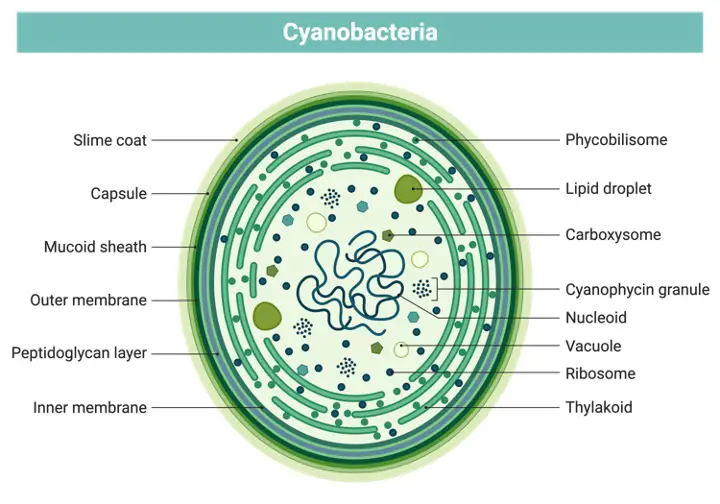Table of Contents
Cyanobacteria Definition
Cyanobacteria, also called blue-green algae, are microscopic organisms found naturally in all types of water. These single-celled organisms live in fresh, brackish (combined salt and fresh water), and marine water
What is Cyanobacteria?
Photosynthetic bacteria that dwell in watery environments and damp soils make up the phylum Cyanobacteria. Others are thought to be endosymbionts, with endosymbiotic plastids seen in many eukaryotic cells. As a consequence of photosynthesis, cyanobacteria are discovered to have a part in generating gaseous oxygen. They’re also thought to have anything to do with the Great Oxygenation Event. Nitrogen-fixing plants are among them. Some create filaments or spheres and live alone or in colonies.
Cyanobacteria Classification
Cyanobacteria was previously known as Cyanophyta and is one of the phyla of the Kingdom Protista in the five-kingdom classification system. Euglenophyta, Chrysophyta, Pyrrophyta, Chlorophyta, Phaeophyta, and Rhodophyta are some of the other phyla.
Because of their photosynthetic capabilities, these phyla are groupings of plant-like protists. Unlike embryophytes, they lack real roots, stems, and leaves. Recent research and discoveries, on the other hand, have resulted in modifications in taxonomic positions and the development of new categorization systems.
Cyanophyta (commonly known as blue-green algae) is currently classified as a phylum of bacteria named Cyanobacteria. This is due to the fact that this clade is made up of prokaryotic organisms.
Blue-green algae are the only prokaryotic algae in phycology; the others are eukaryotes. As a result, they are currently classed as members of the Phylum Cyanobacteria. Chroococcales, Pleurocapsales, Oscillatoriales, Nostocales, and Stigonematales are the cyanobacterial sub-groups based on morphology.
General Characteristics of Cyanobacteria
The presence of pigments (especially phycobiliproteins) in cyanobacteria is responsible for their blue-greenish colour. The phycobiliproteins are phycobilisome components (light-harvesting antennae for cyanobacterial photosystems). On the intracytoplasmic membranes, phycobilisomes are implanted (thylakoids).
Cyanobacteria’s blue-green colouring is due to these pigments, which allow them to generate their own sugar through photosynthesis. Some cyanobacteria (such as Prochlorothrix, Prochlorococcus, and Prochloron) lack phycobilisomes and instead rely on chlorophyll b.
Prokaryotic bacteria are cyanobacteria. They don’t have a nucleus that is attached to the membrane. They do, however, have microcompartments. A carboxysome, for example, is a segmented cage-like structure encased in a protein shell. It is used by cyanobacteria to concentrate CO2 and hence improve the effectiveness of RuBisCo (the CO2-fixing enzyme).
Cyanobacteria have distinct compartments called thylakoids (unlike other photosynthetic bacteria whose thylakoids are continuous with the plasma membrane). The thylakoids are also involved in cellular respiration in addition to photosynthesis.

In the light (during the day), the thylakoid electron transport mechanism is utilised for photosynthesis; in the dark, it is used for respiration (at night). They can be found alone (as unicellular creatures) or in colonies (as multicellular organisms) (forming filaments, such as Anabaena sp).
Filamentous organisms can develop into vegetative cells (photosynthesis cells), akinetes (hardy spores), or heterocysts (spores resistant to harsh environmental conditions) (cells capable of nitrogen fixation by producing the enzyme nitrogenase).
Cyanobacteria may fix nitrogen through heterocysts in addition to photosynthesis. Some of them are immobile, while others gliding motility allows them to move. Hormogonia are cyanobacterial cell filaments that move around. Individual cells can break out from this thread and form a new colony somewhere else.
They create gas vesicles in order to float (a vesicle bounded by a protein sheath and not by a lipid membrane). Binary fission is how cyanobacteria reproduce.
Cyanobacteria and Nitrogen Fixation
Some cyanobacteria are nitrogen-fixing microorganisms. An example is Anabaena. They can transform atmospheric nitrogen into a form (such as ammonia, nitrites, or nitrates) that other species (such as plants and animals) may use and convert into proteins and nucleic acids. Cyanobacteria may fix atmospheric nitrogen by converting into heterocysts, which are specialised cells. When the environment is anoxic and fixed nitrogen is limited, heterocysts develop.
Cyanobacterial Circadian Rhythm
Eukaryotes were formerly considered to be the only ones with a circadian cycle. Scientists later discovered that some cyanobacteria had a circadian rhythm as well.
Cyanobacteria Evolution
Endosymbiotic hypothesis states that eukaryotes that have gained the capacity to photosynthesize originated from primordial eukaryotes that swallowed rudimentary photosynthetic prokaryotes like cyanobacteria. The three major endosymbiotic eukaryotes, green plants, red algae, and glaucophytes, evolved as a result of a primordial endosymbiotic event.
Archaeplastida is a monophyletic group made composed of these three groups. The plastid (chloroplast) that we know today is thought to have evolved from the basic cyanobacterial cell inside the eukaryote.
Morphologically, phylogenetically, genetically, and biochemically, the chloroplast and the cyanobacterial cell appear to have a lot in common. Secondary and tertiary endosymbiotic occurrences followed the original endosymbiosis, and they are thought to have led to later lineages of photosynthetic eukaryotes.
Cyanobacterial Blooms
Cyanobacteria may be found in both aquatic and wet soil environments. In aquatic settings, especially those that are stationary, quiet, or slowly moving, they can also induce algal blooms.
Cyanobacteria produce an algal bloom that looks like a blue-green slime. It may include cyanotoxins (toxins generated by cyanobacteria) that, at certain quantities, can cause serious sickness or death. It has the potential to induce shellfish poisoning and fish death.
Anthropogenic eutrophication of aquatic environments exacerbates cyanobacterial blooms. Rising temperatures, vertical stratification, increased CO2 in the atmosphere, and high phosphorus concentrations can all contribute to the exponential growth of cyanobacterial populations. Neurotoxins, hepatotoxins, cytotoxins, and endotoxins are among the cyanotoxins that can induce respiratory failure in animals ingesting polluted water.
Importance of Cyanobacteria
Cyanobacteria help maintain soil in terrestrial environments, such as wet soil. Their expansion helps to avoid erosion. They aid in the retention of water. Microcoleus vaginatus, for example, is a cyanobacterium that forms a polysaccharide sheath that binds soil particles and aids in water retention.
Cyanobacteria play an important role in the oxygen cycle. Prochlorococcus sp. is responsible for roughly half of the oxygen produced by photosynthesis in the open ocean.
Heterotrophic cyanobacteria are cyanobacteria that eat other cyanobacteria. Some heterorophic parasitic cyanobacteria, such as black band disease, can infect their invertebrate hosts.
Cyanobacteria Citations
- Cyanobacteria evolution: Insight from the fossil record. Free Radic Biol Med . 2019 Aug 20;140:206-223.
- Cyanobacteria as an eco-friendly resource for biofuel production: A critical review. Biotechnol Prog . 2019 Sep;35(5):e2835.
- Cyanobacteria in motion. Curr Opin Plant Biol . 2017 Jun;37:109-115.
- Figures are created with BioRender.com







